There are so many of them, of different shapes and sizes, they look as though they’ve been placed there deliberately to create a work of art. But it’s Nature that’s fashioned this striking sculpture in Grass Wood.
Autumn treasures: searching for fungi at Grass Wood
Grass Wood (C) Rod Jones
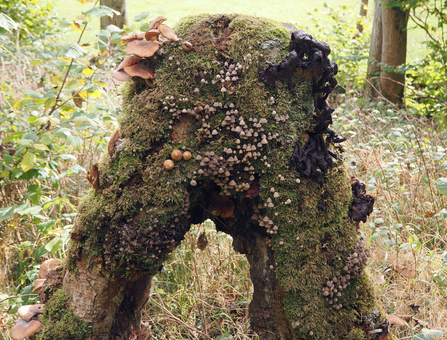
Fungi at Grass Wood (C) Rod Jones
Its most numerous decorations are the fairy inkcaps, delicate little fungi shaped like parasols, growing together in clusters.
There’s a sprinkling of pear-shaped puffballs, which, despite their name, are roughly the same size and shape as conkers. It's also festooned with larger honey mushrooms – a species that seems to be growing everywhere I look during my visit to this reserve, a stone’s throw from Grassington, on a grey autumn day.
On the top right of the arch, there’s a black fungus that looks like stalks that have been charred in a fire. The Seek nature identification app on my phone suggests it’s the rather gruesomely named dead moll’s fingers.
I’m relying heavily on Seek today: more than 400 different types of fungi can be found in Grass Wood and identifying individual species can be an almighty challenge for a novice. Some are edible, but I’d need to be a lot more confident before I risked cooking up a risotto from anything I’ve come across here.
Let’s focus for a moment on three unassuming little orangey-brown mushrooms peeking out from a fallen tree branch. Seek toys with identifying them as edible heath waxcaps, before eventually deciding they’re funeral bells.
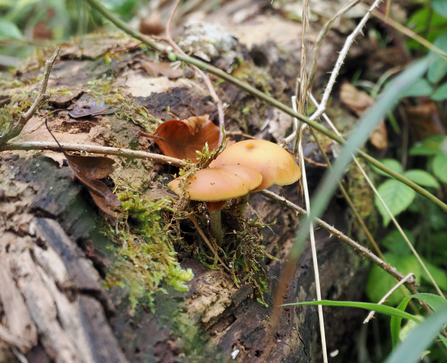
Funeral bell (C) Rod Jones
The clue’s in the forbidding name – funeral bells contain the same potentially fatal toxins as the notorious deathcap. I photograph them from a safe distance, taking care not to touch them.
I spot plenty more weirdly shaped and evocatively named fungi: pestle puffball, common bonnet, snowy waxcap, shaggy scalycap, clouded funnel, earthy powdercap. Many of them are small and tucked away unobtrusively on the ground, nestling among leaf litter or hiding under mossy rocks.
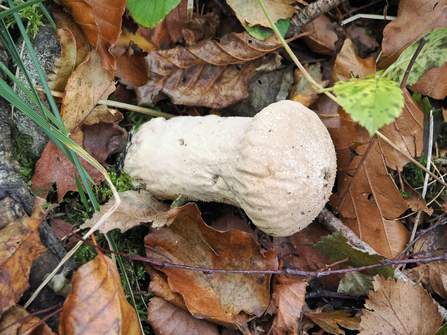
Pestle puffball (C) Rod Jones
It’s worth bearing in mind that these visible fruiting bodies are just the tip of the fungi. Their real bulk is hidden underground or in their food source: a network of fine threads called mycelium, which can grow through soil and wood.
As someone who’s more used to photographing birds, I find it slightly strange to be spending so much time concentrating on the woodland floor, rather than focusing on the trees.
When I do look up, I see a large, hoof-shaped fungus growing on a silver birch branch. It’s the colour of milky coffee on top and white underneath – a birch polypore, a type of fungus used for hundreds of years in traditional medicine.
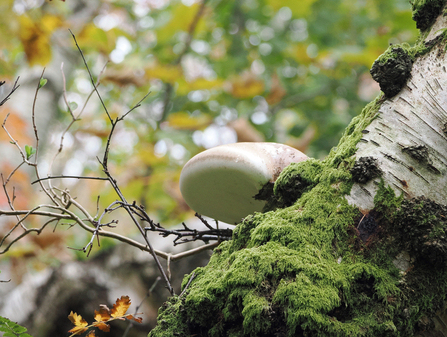
Birch polypore (C) Rod Jones
Nearby, I find the scattered feathers of what looks like a woodpigeon, probably killed in an ambush attack by a sparrowhawk. I can hear birds in the trees – the sweet song of a robin; the soft, shy whistle of bullfinches; the raucous screech of jays; the chip-chip-chip call of a great spotted woodpecker.
There’s another noise, too – a faint pitter patter. At first, I think it’s light rain, although the weather is forecast to be dry. Then I realise it’s the sound of autumn in the woods – leaves falling off the trees and dropping to the ground.
At 78 hectares, Grass Wood is one of the largest areas of broadleaf trees in the Yorkshire Dales. It’s a particularly precious landscape in this part of the world, where tree cover is just over four per cent, compared with a national average of around nine per cent.
Walk around the reserve and you soon discover another rare natural phenomenon that makes this such a special place: many of the paths are rocky because the trees grow on a series of limestone terraces.
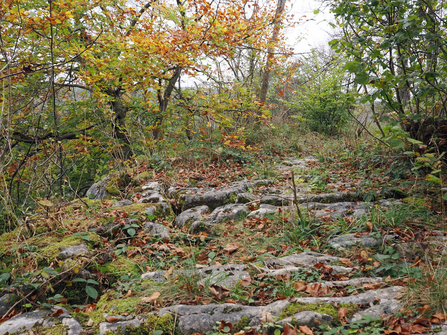
Grass Wood limestone path (C) Rod Jones
It’s tricky underfoot, but fascinating to look at: a woodland dotted with boulders, natural walls and rocky viewpoints. I stand on one of these to photograph the landscape looking across Wharfedale towards Cracoe Fell – featured in the shot at the top of this blog.
The trees are approaching their peak autumn colours – a gorgeous tapestry of reds, oranges, yellows, greens, browns and golds. I find a blackthorn tree laden with plump, deep purple sloes. You can pick them and use them for making gin, but I’m happy to leave them for the blackbirds and winter thrushes to feast on.
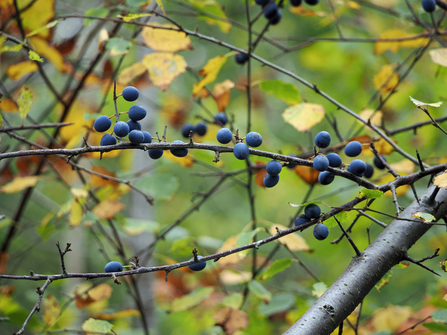
Blackthorn sloe berries (C) Rod Jones
Beeches are among the most colourful trees here, brightening up this dull October day. I pause to take some close-up shots of their pointed, oval leaves – each one a miniature work of art, with its symmetrical, perfectly-spaced lines.
Then I notice a tiny shape on an orange leaf. It’s a seven-spot ladybird – a little reminder of summer, clinging on as autumn takes over.
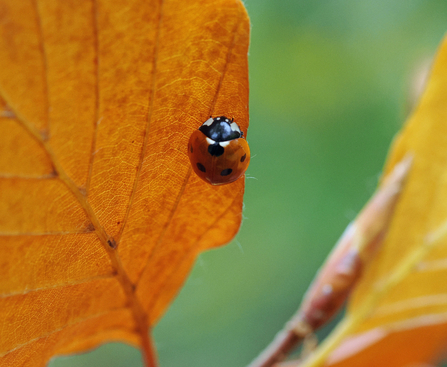
Seven-spot ladybird on beech leaf (C) Rod Jones
Soon, it’ll be going into diapause – the insect version of hibernation – for the winter. When it emerges in spring, the fungi will have vanished, and bluebells and primroses will be taking their place in this precious and ever-changing woodland.
*Vital wild places like Grass Wood are under threat. Research shows that, without rapid intervention, we will see total ecosystem collapse in Yorkshire’s woodlands in the next 50 years.
Yorkshire Wildlife Trust has launched a campaign to save them. For more information, visit www.ywt.org.uk/woodlands

